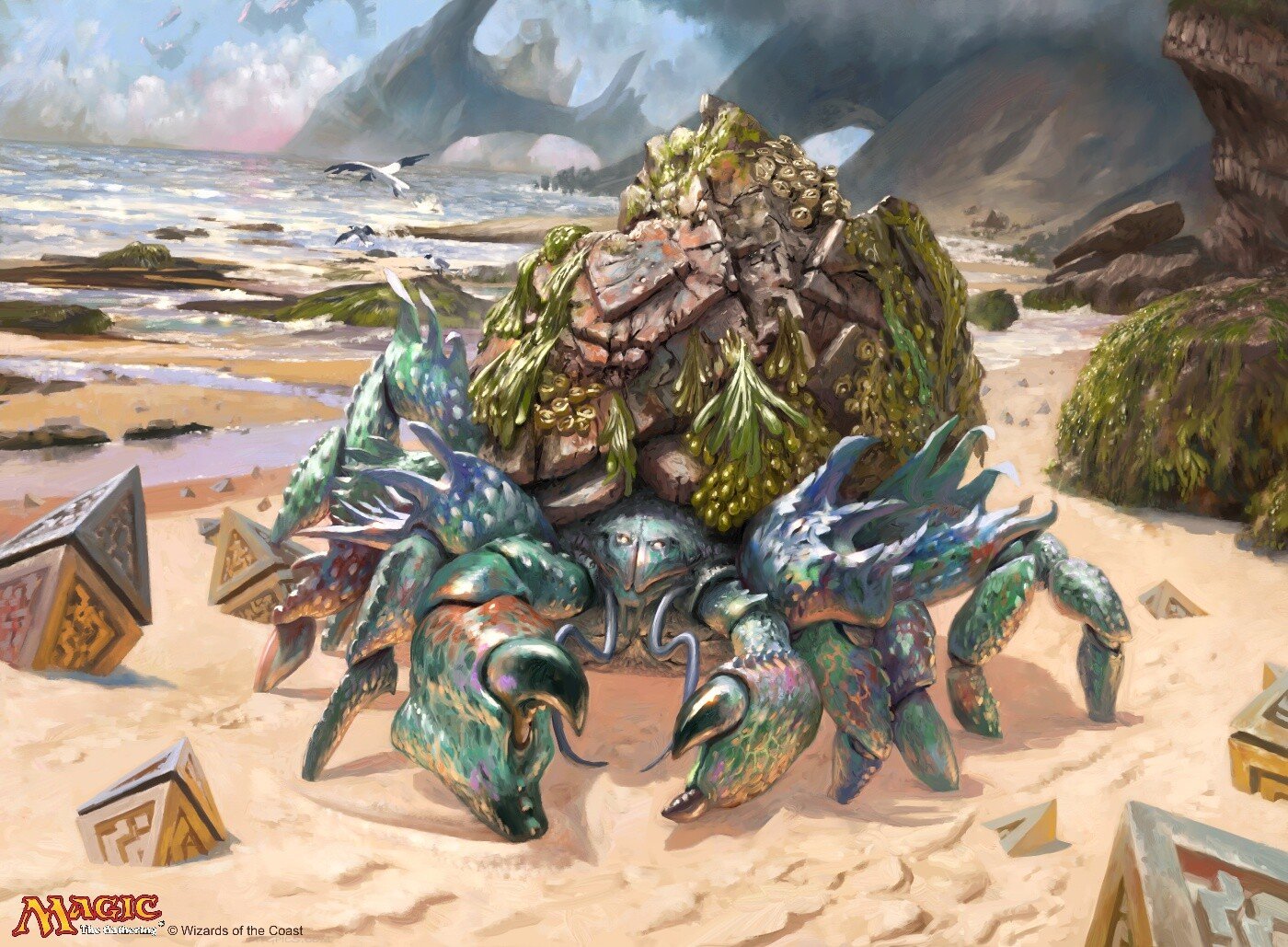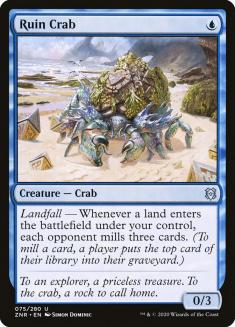After graduating from the “my decks = the cards I own” stage of Magic, the first deck I ever built was a rough approximation of the eighth-place deck from the inaugural Magic: the Gathering Pro Tour — Shawn “The Hammer” Regnier’s Blue-White (Azorius was still close to a decade away) Control.
Lands (23)
Spells (37)

It’s odd that I ended up copying Regnier’s version of Blue-White Control rather than champion Michael Loconto’s. After all, my Magic thinking was far from refined at this moment in time. Decks that won were better than the decks that didn’t. Anything published in The Duelist, Inquest, or Scrye Magazine was gospel. But even at this nascent stage of my strategy gaming development, I still had respect for linearity.
A four-mana 2/2 flyer!? In my control deck? I don’t think so friend. Why bother, when I could just win the game with a card that simultaneously denied you access to your best cards?
My actual favorite Magic card of all time, Millstone is the first card I ever purchased the upgraded version of. I saved up for weeks so I could have Antiquities Millstones as opposed to the sinfully ugly Revised version in my deck.
As the world of Magic opened up to me, Millstone became emblematic of the things about the game I found appealing. While Magic was ostensibly a game about creatures and combat, there was nothing forcing you to approach it in this fashion. You could carve out your own playstyle, and if you wanted to deny your opponent meaningful access to the game, Magic gave you the tools to do so.
I played hundreds, if not thousands of games against my brother with my Blue-White Control deck, happily milling him out by virtue of either my superior play skill or the fact that, since I was older, my allowance was ten dollars a week and his was only five. Three packs a week to his one meant my decks upgraded way faster. Welcome to capitalism eight-year old Justin. Force of Will your Deadly Insect.
Fast forward nearly 25 years, and unfortunately my opponents’ wallets are now keeping pace with mine. I’m still here trying to mill them out though.
Ruin Crab in Zendikar Rising Standard benefits from many of the same principles that propelled Millstone to greatness. First, opponents are unable to reset your progress towards winning the game. Omnath, Locus of Creation continues to be the focal point of the Standard metagame, and its lifegain has often made me feel foolish for attacking. Having multiple turns’ worth of progress wiped out by an act as simple as deploying a land can be heartbreaking. The one thing Omnath can’t do is emulate Feldon’s Cane, a card so powerful that it was restricted in Standard.

Ruin Crab also legitimately achieves what we only thought our Millstones were doing: it is denying opponents access to key cards. Which key cards? Island, Plains, Mountain, and Forest. Manabases for Omnath decks are really only squeezed by their access to basic lands. With Cultivate, Beanstalk Giant, Fabled Passage, and Evolving Wilds all competing for basics, getting lucky and putting the right basics in the bin can have a material impact on your opponent’s gameplan. It’s not a reason to attempt to mill out your opponent, but it’s a nice little bonus.
Finally, there are now several cards that are powered up by the size of your opponent’s graveyard, and these cards line up fairly well with the rest of the format. Making Drown in the Loch a real counterspell and an out to a resolved Omnath gives control decks what they need to adapt to non-optimal situations, and Into the Story has been a key part of some combo plans as well.
Speaking of combo, let’s start our exploration there.
Creatures (18)
Lands (18)
Spells (24)

If I’ve got a hyper-linear combo deck that will have a hard time standing up to disruption, I’ll often send it off to the Best-of-One queues where things tend to be a little more welcoming. This comboish approach to Temur Mill has been a blast to run in that space, even if I don’t think it’s the most competitive of ideas.
If you’ve played at all with my Nahiri’s Lithoforming decks, you understand why I keep coming back to the card. The powerful turns are “broken” in the truest sense of the word. Here, we’re just looking to accumulate some Lotus Cobras via Glasspool Mimics and Bala Ged Recovery, and then power through the entirety of our deck with the help of Song of Creation and Nahiri’s Lithoforming. Add a Crab to the mix at some point and it’s pretty trivial to mill your opponent out. Just don’t ever cast the second Song of Creation. You will deck yourself.
It’s cute to have massive turns, and your poor opponents will definitely find themselves suffering through your ten-minute turns while their deck drifts away. However, you’re too reliant on keeping a Lotus Cobra on the battlefield to be a legitimate contender. This next deck was my attempt to remedy the situation.
Creatures (17)
Lands (21)
Spells (22)

We’ve diversified our paths to victory with the addition of Teferi’s Tutelage to the deck. When combined with Into the Story, we’ve set up a reliable card advantage engine that allows us to play something resembling combo control. The Adventure creatures are among the best things to be doing in Standard, even before you combine them with Song of Creation, but in that scenario, your deck unlocks a bunch of single-turn kills. It generally takes multiple Tutelages to reach that point, but if you are ripping through your deck with Song of Creation, you’ll get there.
This deck plays a bit soft to Omnath in pre-sideboard games and is built for a more diverse field than the metagame presently provides. If I was instead looking to focus more on doing my best to take down the four-armed menace, I’d look into Dimir Mill.
Dimir Mill is the purest callback to the Blue-White Control decks of yesteryear. Counter all your stuff. Kill all of your creatures. Draw some cards. Put your deck in your graveyard. GG. This deck has a rarity for a control build — an extremely powerful nut draw. There are games where you play a Ruin Crab on Turn 1 and get to hold up Drown in the Loch as countermagic for the rest of the game, all the time refilling your hand with Into the Story, Silundi Vision, and Mazemind Tome.
It might be surprising just how hard we are going on card draw here, but our deck is almost all one-for-ones and the metagame is loaded with supremely powerful end-games. You need to be able to answer almost every spell your opponent will cast.
This deck excels at picking apart the plan of the traditional Omnath ramp decks, but things get much harder against Four-Color Adventures builds due to Lucky Clover. It’s also tough to turn the corner against things like Mono-Green Aggro in Game 1s. You’ve got a lot of cards that don’t affect the battlefield and Ruin Crab is too small to be an effective blocker against their big bodies.
Working on this deck had me exploring some hybrid plans that played some Rogues alongside Ruin Crab. Ultimately, I found Ruin Crab to be unnecessary and I came up with a much leaner build of Rogues along the way.
Creatures (18)
- 4 Vantress Gargoyle
- 4 Thieves' Guild Enforcer
- 4 Merfolk Windrobber
- 2 Thieving Skydiver
- 4 Soaring Thought-Thief
Lands (21)
Spells (21)

Dimir Rogues had a big weekend, and honestly, I’m a little surprised. I’ve been underwhelmed with the version of the deck that was trying to bank on Rankle, Master of Pranks and Zareth San, the Trickster. It just felt too easy to get punished when tapping out. My build looks to do things in a much leaner fashion, and the real all-star here has been Vantress Gargoyle. It’s both a quick clock and a meaningful blocker against aggro, while also coming down on a turn before your opponent can look to punish you with a haymaker. Meanwhile, Thieving Skydiver isn’t a great Magic card, but it does do an important job against Lucky Clover, and maybe someday you’ll get to steal a Maul of the Skyclaves.
You also get to pick up some meaningful recursion with a companion Lurrus of the Dream-Den and some strong five-mana Agadeem’s Awakenings. This lets us grind against the decks that will surely pop up to attempt to exploit Rogues, and we still have access to the tempo plan that has given Omnath decks fits. Oh, and about those decks looking to exploit mill strategies:
Creatures (23)
- 3 Rankle, Master of Pranks
- 2 Murderous Rider
- 4 Bonecrusher Giant
- 4 Mire Triton
- 4 Kroxa, Titan of Death's Hunger
- 2 Terror of the Peaks
- 4 Magmatic Channeler
Lands (19)
Spells (18)

This deck has been everywhere over the past week or so, and boy does this look like a deck from 2016. Everything seems underpowered and way too fair for the present world. But you know what? It’s not bad. Granted, data suggests it still gets thrashed by the metagame’s extreme power outlier, Four-Color Adventures, but it does a great job against the decks that aren’t attempting absurd things. In particular, it is a nightmare for any deck mentioned here, since it does such an effective job both managing and leveraging its graveyard.
On the whole, the metagame feels way healthier than expected. Four-Color Adventures is a clear front-runner, and some tournament data from the past weekend showed it exhibiting a positive matchup against every single deck in the format. That’s really scary, but the sample sizes were small, and it feels like traditional Omnath Ramp has only just passed over the mantle of “best deck” to Four-Color Adventures. Does Four-Color Adventures remain as far ahead of the field when it’s the one wearing the target? I suspect the answer is yes, but I’m happy to be proven wrong.
I’m actually enjoying exploring this format, even if it took me consenting to living in Tier 2 to do so. If you’re asking me what the best deck is or what you should be playing on ladder, I’m confidently answering Four-Color Adventures. However, I think you can find some slight metagame churn, and make a reasonable argument that there are other decks that merit consideration in tournament fields. Omnath decks will have to get a lot of things right to put themselves ahead of the pack every week, and there is value in punishing any missteps they might make.





